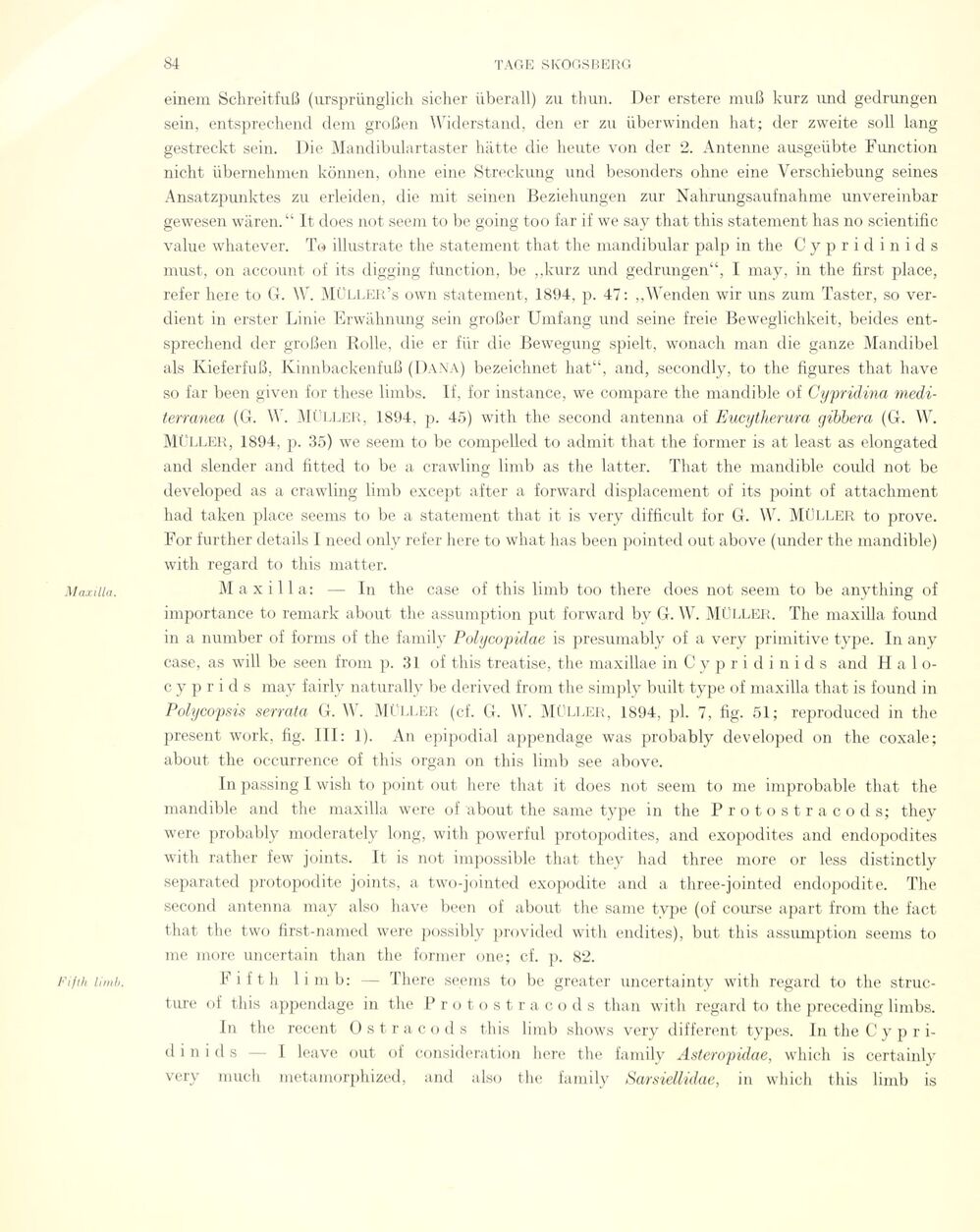
Full resolution (JPEG) - On this page / på denna sida - Sidor ...

<< prev. page << föreg. sida << >> nästa sida >> next page >>
Below is the raw OCR text
from the above scanned image.
Do you see an error? Proofread the page now!
Här nedan syns maskintolkade texten från faksimilbilden ovan.
Ser du något fel? Korrekturläs sidan nu!
This page has never been proofread. / Denna sida har aldrig korrekturlästs.
Maxilla.
Fifih Unib.
einem Schreitfuß (ursprünglich sicher überall) zu thun. Der erstere muß kurz und gedrungen
sein, entsprechend dem großen Widerstand, den er zu überwinden hat; der zweite soll lang
gestreckt sein. Die Mandibulartaster hätte die heute von der 2. Antenne ausgeübte Function
nicht übernehmen können, ohne eine Streckung und besonders ohne eine Verschiebung seines
Ansatzpunktes zu erleitlen, die mit seinen Beziehungen zur Nahrungsaufnahme unvereinbar
gewesen wären. “ It does not seem to be going too far if we say that this statement has no scientific
value whatever. Tu illustrate the statement that the mandibular palp in the Cypridinids
must, on account of its digging function, be ,,kurz und gedrungen“, I may, in the first place,
refer here to G. W. MÜLLER’s own statement, 1894, p. 47: „Wenden wir uns zum Taster, so
verdient in erster Linie Erwähnung sein großer Umfang und seine freie Beweglichkeit, beides
entsprechend der großen Rolle, die er für die Bewegung spielt, wonach man die ganze Mandibel
als Kieferfuß, Kinnbackenfuß (Dana) bezeichnet hat“, and, secondly, to the figures that have
so far been given for these limbs. If, for instance, we compare the mandible of Cypridina
mediterranea (G. W. MÜLLER, 1894, p. 45) with the second antenna of Eucytherura gibbera (G. W.
Müller, 1894, p. 35) we seem to be compelled to admit that the former is at least as elongated
and slender and fitted to be a crawling limb as the latter. That the mandible could not be
developed as a crawling limb except after a forward displacement of its point of attachment
had taken place seems to be a statement that it is very difficult for G. W. Müller to prove.
For further details I need only refer here to what has been pointed out above (under the mandible)
with regard to this matter.
Maxilla: — In the case of this limb too there does not seem to be anything of
importance to remark about the assumption put forward by G. W. Müller. The maxilla found
in a number of forms of the family Polycopidae is presumably of a very primitive type. In any
case, as will be seen from p. 31 of this treatise, the maxillae in Cypridi nids and
Halo-c y p r i d s may fairly naturally be derived from the simply built type of maxilla that is found in
Polycopsis serrata G. W. MÜLLER (cf. G. W. MÜLLER, 1894, pi. 7, fig. 51; reproduced in the
present work, fig. III: 1). An epipodial appendage was probably developed on the coxale;
about the occurrence of this organ on this limb see above.
In passing I wish to point out liere that it does not seem to me improbable that the
mandible and the maxilla were of about the same type in the Protostracods; they
were probably moderately long, with powerful protopodites, and exopodites and endopodites
with rather few joints. It is not impossible that tliey had three more or less distinctly
separated protopodite joints, a two-jointed exopodite and a three-jointed endopodite. The
second antenna may also have been of about the same type (of course apart from the faet
that the two first-named were possibly provided with endites), but this assumption seems to
me more uncertain than the former one; cf. p. 82.
Fifth limb: — There seems to be greater uncertainty with regard to the
structure of this appendage in the Protostracods than with regard to the preceding limbs.
In the recent Ostracods tilis limb shows very different types. In the C y p r
i-d i n i d s — I leave out of considération here the family Asteropidae, which is certainly
very mueh metamorphized, and also the family SarsieUidae, in which this limb is
<< prev. page << föreg. sida << >> nästa sida >> next page >>